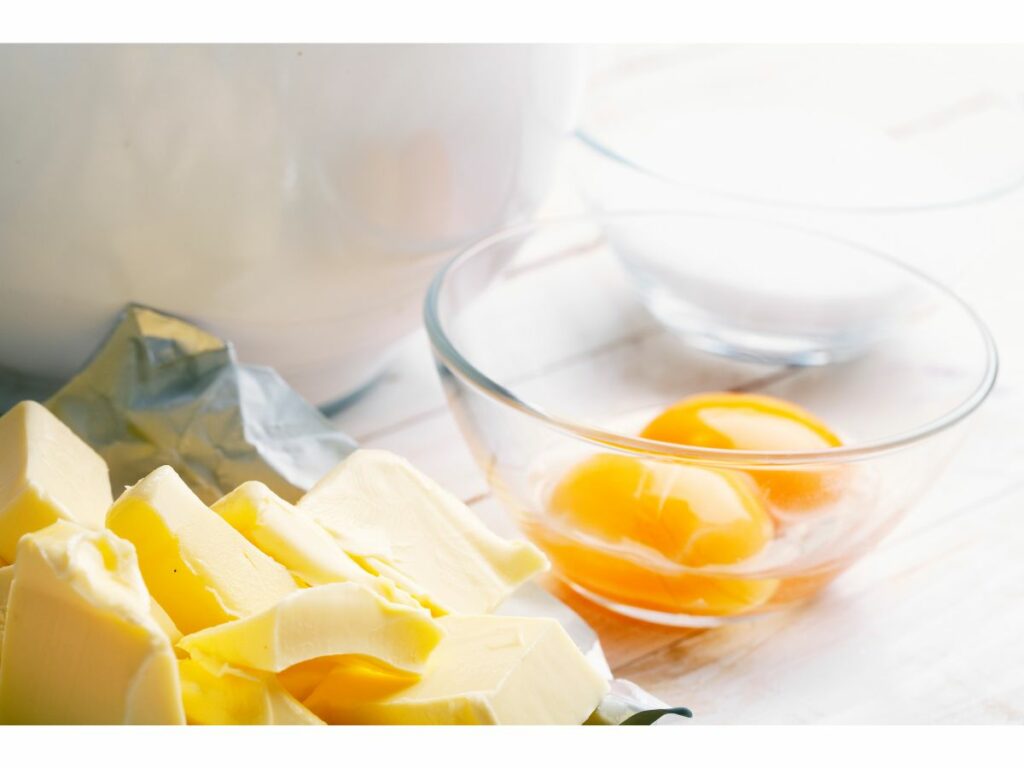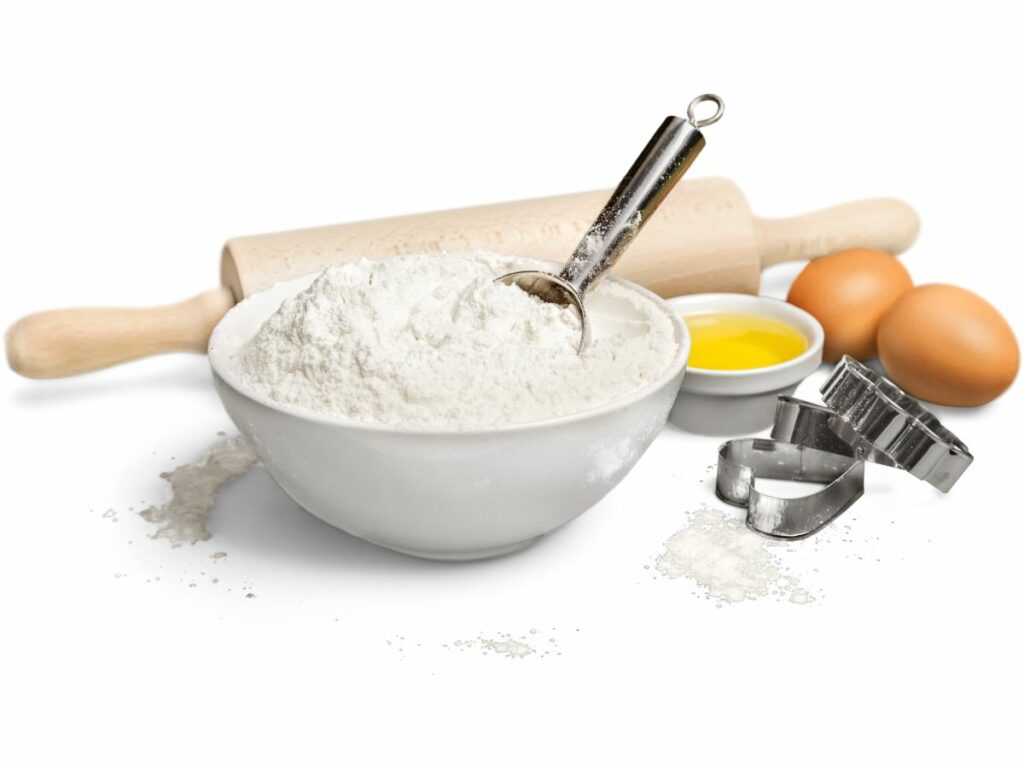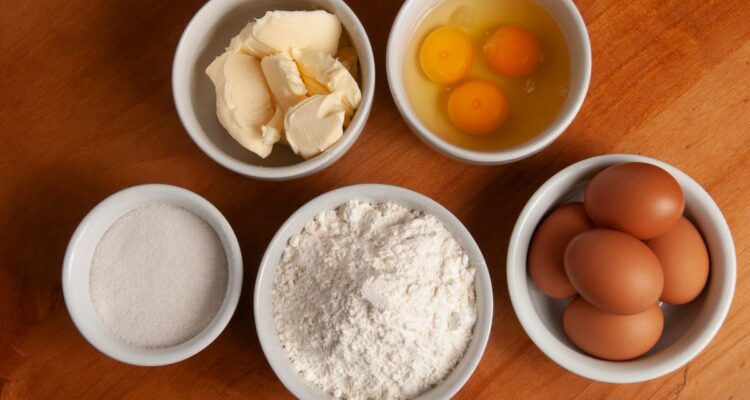When it comes to baking, the age-old debate of margarine vs. butter raises many questions among bakers and consumers alike. As a key ingredient in a wide range of recipes, both margarine and butter serve similar purposes and can often be used interchangeably. However, when striving for that perfect taste and texture, the choice between these two fats becomes critical.
While margarine may give baked goods a softer texture, which some people prefer, and contains more polyunsaturated and monounsaturated fats, it also often contains trans fats which are less desirable. Butter, on the other hand, is firmer at room temperature due to its saturated fat content, but its richness and natural flavor make it stand out in comparison.
Margarine vs Butter: Basic Differences
Origins and Composition
Margarine and butter are two common and quite similar products, but with slightly different origins and compositions. Butter is made from heavy cream, which is a dairy product. On the other hand, margarine is a plant-based product, made from vegetable oils such as soybean, corn, or sunflower oil. While both serve similar purposes in cooking and baking, their slightly different compositions can lead to different results in baking.
Fat Content and Types
One of the main differences between these two is in the type of fat they contain. Butter has higher levels of saturated fat, which was falsely associated with cholesterol and health risks, however, now it’s clear that cholesterol levels do not play any roll in heart disease. Margarine, on the other hand, contains more polyunsaturated and monounsaturated fats, both once considered healthier options. However, some margarines may also contain trans fats, which are undesirable and should be avoided if possible.
When it comes to baking, the different fat contents can produce varying results. Margarine often gives baked goods a softer texture compared to butter, which some people might prefer. However, butter, with its high saturated fat content, contributes to a firmer structure and provides that distinct, rich flavor we all love. Show me a person who prefers the taste of margarine to butter! So far, I haven’t seen a single one.
I find that using butter in baking generally produces more favorable results compared to margarine. The rich, natural flavor of butter elevates the taste of baked goods and offers a better overall experience. Additionally, many bakers tend to prefer using unsalted butter, as it lets them control the salt content in their recipes. With that said, margarine can be useful for those looking to avoid dairy.
Effect on Baking Results
Texture and Consistency
When it comes to baking, I find that the texture and consistency of the final product can be affected by the choice of butter or margarine. Butter is made from churned milk, which contains more saturated fats. As a result, it provides a firm texture to baked goods. In contrast, margarine has more polyunsaturated and monounsaturated fats which give it a softer texture. Many people prefer softer textured baked goods, particularly in items like cookies, cakes, and pastries.
For instance, if I’m baking shortbread cookies or bars, I would choose butter over margarine because the saturated fats contribute to a crumbly, tender texture, while using margarine might result in a softer and less desirable consistency. The same goes for biscuits, as butter generally creates flaky layers due to its solid-at-room-temperature properties.
Flavor Profile
One of the most significant differences between butter and margarine is their flavor profiles. Butter has a rich, creamy taste that comes from the milk it’s made from, whereas margarine is made from vegetable oils and may have a more neutral flavor. When I’m baking desserts, such as cakes and pastries, I find that the added depth of flavor from butter can’t be replicated by margarine.
Moreover, butter also has a higher melting point, which means it melts slower in the oven, causing the spread of cookies and other baked goods to be more controlled, maintaining their shape. This results in a more appealing appearance and a desirable texture.
In conclusion, I favor in baking due to its ability to provide better texture, consistency, and flavor to the final product, compared to margarine. Baking with butter enhances the taste and overall quality of baked goods and makes them more enjoyable for everyone. Plus, margarine tends to leave an unpalatable, almost plastic coating on the tongue — doesn’t sound very favorable to me!
Margarine vs Butter in Baking
When it comes to baking, choosing between butter and margarine can greatly affect the final result. Let’s compare these two ingredients even closer.
Butter in Baking
Butter, made from churned milk, has a high fat content, making it ideal for creating tender, flaky pastries and rich, moist cakes. Butter provides flavor, richness, and structure to baked goods. It also encourages browning, giving your treats that classic golden hue.
Margarine in Baking
On the other hand, margarine is made from vegetable oils and has a similar fat content to butter. While it can be used interchangeably in many recipes, it typically serves different purposes in baking. Margarine can sometimes result in softer, less flaky pastries and may not provide the same depth of flavor as butter does.
Why I Prefer Butter
As a baker, I often choose butter over margarine for several reasons:
- Flavor: Butter imparts a more distinct and richer taste to baked goods compared to margarine.
- Structure: The saturated fats in butter create sturdier pastries, pie crusts, and cookies.
- Less Water Content: Butter’s lower water content ensures better browning and crispiness in recipes.
Of course, the choice isn’t always as simple as butter vs. margarine. Each ingredient has its merits, depending on the specific recipe and dietary preferences. So, when you’re deciding between the two for your baking projects, here are some quick guidelines:
- Use butter for recipes that require a richer flavor, crispier or flakier texture, and better browning, such as pie crusts, pastries, and some cookies.
- Opt for margarine when baking items that should have a softer texture or when catering to dairy-free diets.
In conclusion, while margarine has its place in certain recipes and dietary preferences, butter offers a more favorable taste and texture in baking. By understanding the properties of each ingredient, you can make informed decisions when choosing the right option for different recipes.

Health Implications
Heart Disease and Cholesterol
When considering the health implications of butter and margarine, it’s essential to discuss their impacts on heart disease and cholesterol. Butter contains more saturated fat than margarine, which was once considered to raise low-density lipoprotein (LDL) or “bad” cholesterol levels. Nowadays, this myth is busted into pieces and we can enjoy our butter without guilt. On the other hand, margarine tends to contain trans fats, which have also been linked to an increased risk of heart disease. Unfortunately, most modern margarines still contain inflammatory polyunsaturated fats and trans fats.
Dietary Restrictions and Preferences
It’s important to consider dietary restrictions and preferences when choosing between butter and margarine. For example, vegans and those with a lactose intolerance may opt for margarine due to its plant-based composition. Margarine products containing omega-6 fatty acids from polyunsaturated vegetable oils can cause inflammation and risk your heart health, whereas butter is a more natural product containing conjugated linoleic acid (CLA) with potential health benefits. It’s essential to weigh the pros and cons to determine which option is better suited for your specific needs and preferences.
To sum up, while butter is typically more favorable for taste and texture in baking, it’s crucial to consider the health implications and individuals’ dietary restrictions when making a choice between butter and margarine. Both have their advantages and drawbacks, so it ultimately depends on the specific situation and personal preferences.
Exploring Substitutions and Alternatives
As a baker, I always appreciate finding alternative ingredients that can improve both the taste and nutritional value of my creations. One popular replacement for butter and margarine is olive oil or a more neutral tasting oil such as canola oil. With its high content of monounsaturated fats, olive oil is a heart-healthy option. When substituting with olive oil (or another vegetable oil), use about ¾ of the amount of butter or margarine the recipe calls for. However, if the recipe asks for melted butter, feel free to swap equal amounts.
Another option to consider is avocado. As a natural source of healthy fats, it can add richness and a creamy texture to baked goods without the downsides of some animal fats. Avocado may change the final color of your product, but it is an excellent choice for anyone seeking a nutritious twist to their recipes.
Nuts, such as almonds, walnuts, and pecans, can be incorporated into your baking as a source of healthy fats. Their unique flavors and textures can elevate your desserts while still providing the much-needed fat content in the recipe. Keep in mind that adding nuts may alter the original appearance and texture, and they can enhance the overall nutritional value.
In baking, it’s important to strike a balance between monounsaturated and polyunsaturated fats to ensure a healthier final product. Some dairy-free recipes resort to using plant-based butters, which may contain a blend of monounsaturated, polyunsaturated, and even saturated fats. These plant-based alternatives are excellent for vegans and those with lactose intolerance; however, always check the ingredient list to avoid any unwanted trans fats.
Labeling and Quality Considerations
When comparing margarine and butter in baking, it is essential to consider the labeling and quality of the products. I make sure to read the nutrition labels on both margarine and butter packages. This provides insight into their fat content, salt content, and overall quality, which may affect my baking results.
In terms of fat content, butter typically contains a higher percentage of butterfat, usually around 80%, while margarine may vary between 35% and 80% fat. Butterfat is responsible for the rich flavor I love in my baked goods, which is why I might favor butter over margarine in some recipes. However, the fat content in margarine can influence its texture and consistency, so I always check the label to understand how it will perform in my baking.
Margarine comes in different forms, such as stick margarine, tub margarine, and light margarine. Stick margarine is firmer and more suitable for baking, while tub margarine is softer and more spreadable, ideal for spreading on toast or melting over vegetables. Light margarine has a lower fat content and a higher water content, which I generally avoid using in baking as it can yield unappealing results.
Butter is available in both salted and unsalted varieties. While salt is a flavor enhancer, it’s essential for me to control the salt content in my baked goods. I often opt for unsalted butter when baking, as it allows me to add the exact amount of salt needed for each recipe.
Finally, it is worth noting that the quality of butter and margarine is another consideration. A high-quality butter will typically contain pure butterfat and buttermilk, whereas a lower-quality margarine might contain additional filler ingredients. To ensure the best results in my baking, I choose products with minimal additives and high-quality ingredients.
In conclusion, butter is often preferred in baking due to its rich flavor and the control it provides over salt content. However, it’s important to carefully read the labels on both margarine and butter and consider their quality, fat content, and form for optimal results.

Practical Tips for Baking with Butter and Margarine
Here are some practical tips to consider when baking with butter and margarine:
- Use unsalted butter to control the salt content in your recipe.
- For a vegan option, consider using margarines with lower fat and cholesterol levels.
- Always soften butter and margarine before using them in recipes (if directed, that is), as this ensures even incorporation of the ingredients.
- If you’re concerned about butter’s higher fat content, try experimenting with half butter and half avocado or apple sauce in your recipes to find the balance that works best for you.
In conclusion, while both butter and margarine have their benefits in baking, butter provides a richer taste and better overall texture, making it the preferred choice for many bakers. Margarine does offer a viable alternative for those looking to reduce fat and cholesterol levels in their baked goods. By understanding the differences between the two and knowing how to adjust your recipes accordingly, you can achieve the perfect balance for your desired baking outcome.
Conclusion: Why I Prefer Butter In Baking
As a baking enthusiast, I’ve experimented with both butter and margarine in various recipes. After thoroughly analyzing the effects of each, I can confidently state that I prefer butter over margarine in baking. Let me share my reasons for this preference.
Butter, a dairy product, is made from cream, which makes it a more natural and unprocessed choice compared to margarine. Margarine, on the other hand, is typically created from refined vegetable oils and emulsifiers. For me, using butter aligns with my preference for natural ingredients in my baking endeavors.
Another noticeable difference between the two is the taste. Butter’s rich flavor is unmistakable, adding depth to any baked good. The aroma of butter when baking is simply irresistible. Margarine, while it can still provide a pleasant taste, lacks the creamy richness that butter contributes to a dish.
When it comes to the texture of baked goods, I find that butter produces fluffy, moist, and tender results. This is mainly due to its higher fat content, which affects the overall structure of the baked confection. Margarine can sometimes alter the texture, making the final product slightly different in consistency.
While margarine can be a suitable substitute in baking and offer some benefits, such as a softer texture and a lower cholesterol and saturated fat content, I believe that the superior taste, aroma, and natural composition of butter make it my go-to choice in baking. To me, butter stands out as the best ingredient to elevate my baked creations to the next level.
Frequently Asked Questions
What is the difference between butter and margarine in cookies?
Butter and margarine affect cookies differently in terms of taste and texture. Butter typically contributes to a more delicate, flavorful, and crisp texture while cookies made with margarine tend to be softer, chewier, and may spread more during baking due to their oil makeup.
How do margarine and butter affect bread baking?
In bread baking, both butter and margarine may provide a tender and moist crumb, as well as contribute to browning. However, butter often delivers a richer flavor that many bakers prefer over margarine. Margarine, on the other hand, may yield a softer crumb due to its oil content.
Which is the best margarine for baking cakes?
When choosing a margarine for baking cakes, I recommend selecting a good-quality, full-fat margarine that does not contain excess water, as this may impact the cake’s texture. Checking the ingredients and opting for a margarine with a higher fat content generally yields better results in baking.
What are the advantages of using butter in baking?
Butter boasts several advantages in baking, including a superior, natural flavor, a flakier texture in pastries, and a more predictable outcome due to its consistent composition. Additionally, using butter may result in better browning and a more attractive appearance in your baked goods.
In a comparison of healthiness, which is better: margarine or butter?
The choice between margarine and butter in terms of health largely depends on personal dietary preferences and needs. Butter is a natural product, high in saturated fats which are neutral or even beneficial to your health, while margarine typically contains unsaturated fats and inflammatory omega-6 fatty acids. It’s essential to balance taste preferences, nutritional needs, and overall health goals when making this choice.
Can margarine be used as a substitute for butter in various cooking methods?
Margarine may be used as a substitute for butter in many cooking methods, including baking, frying, and sautéing. However, it’s essential to consider the flavor and texture differences that may result from using margarine in place of butter and make adjustments accordingly to achieve the desired outcome.

